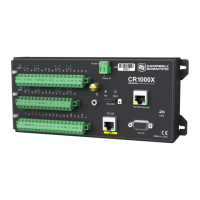Float or Long integer is converted to a Boolean, zero is False (0), any non-zero value will set
the Boolean to True (-1). The Boolean data type allows application software to display it as an
On/Off, True/False, Red/Blue, etc.
The CR1000X uses –1 rather than some other non-zero number because the AND and OR
operators are the same for logical statements and binary bitwise comparisons. The number -1 is
expressed in binary with all bits equal to 1, the number 0 has all bits equal to 0. When –1 is anded
with any other number the result is the other number, ensuring that if the other number is non-
zero (true), the result will be non-zero
As String * size specifies the variable as a string of ASCII characters, NULL terminated,
with an optional size specifying the maximum number of characters in the string. A string is
convenient in handling serial sensors, dial strings, text messages, etc. When size is not specified,
a default of 24 characters will be used (23 usable bytes and 1 terminating byte).
As a special case, a string can be declared As String * 1. This allows the efficient storage of a
single character. The string will take up 4 bytes in memory and when stored in a data table, but it
will hold only one character.
4.4.2 Data storage
Data can be stored in either IEEE4 or FP2 formats. The format is selected in the program
instruction that outputs the data, i.e. minimum, maximum, etc.
While Float (IEEE 4 byte floating point) is used for variables and internal calculations, FP2 is
adequate for most stored data. Campbell Scientific 2 byte floating point (FP2)provides 3 or 4
significant digits of resolution, and requires half the memory space as IEEE4 (2 bytes per value
vs 4).
Table 4-2: Resolution and range limits of FP2 data
Zero Minimum magnitude Maximum Magnitude
0.000 ±0.001 ±7999.
The resolution of FP2 is reduced to 3 significant digits when the first (left most) digit is 8 or
greater. Thus, it may be necessary to use IEEE4 output or an offset to maintain the desired
resolution of a measurement. For example, if water level is to be measured and output to the
nearest 0.01 foot, the level must be less than 80 feet for FP2 output to display the 0.01 foot
increment. If the water level is expected to range from 50 to 90 feet the data could either be
output in IEEE4 or could be offset by 20 feet (transforming the range to 30 to 70 feet).
4. Data 32

